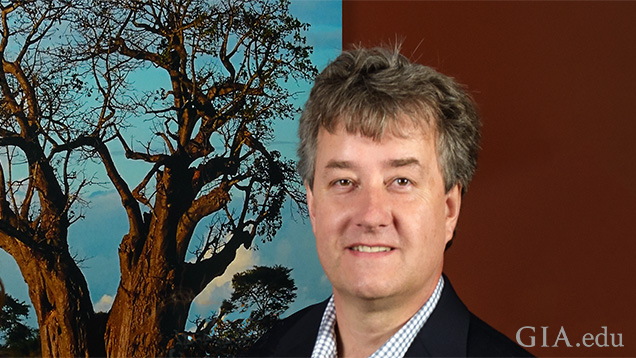The World’s Biggest Diamonds: Windows into the Earth’s Deep Mantle

For geoscientists and gemologists alike, the origins of large, high-clarity, and relatively pure diamonds, like the Cullinan and the 812.77 ct Constellation on the cover of this issue, have long been an enigma. In a December 2016 Science article, a team of researchers led by GIA’s Dr. Evan Smith provided important insights into how these rare and extraordinary gems form deep in the earth’s mantle.
Natural diamonds are science’s best tools for understanding the depths of the earth.
That article presented evidence that such Cullinan-like, nitrogen-poor “CLIPPIR” diamonds contain high-pressure mineral inclusions that are only stable at depths of 360–750 km (approximately 225–465 miles). By contrast, the bulk of gem-quality diamonds form in the base of continental tectonic plates at depths of 150–200 km (95 to 125 miles). Inclusion-bearing CLIPPIR diamonds constitute only 1 in 10,000 of those submitted to GIA’s laboratories. The inclusions these big diamonds carry—iron-nickel metal with minor sulfur and carbon—truly are a window into the earth’s deeper mantle. In our lead paper, Evan Smith and Wuyi Wang partner with Steven B. Shirey of the Carnegie Institution for Science to build on the landmark Science article. They provide more detail on the key features of these remarkable diamonds as well as data on additional samples.
Our second paper, by Robert Weldon, Cathleen Jonathan, and Rose Tozer of GIA’s Richard T. Liddicoat Library, explores the astonishing work of a multigenerational family of gem carvers: the Drehers of Idar-Oberstein, Germany. The authors focus on the contemporary craft of Gerd Dreher and his son, Patrick, artisans with an unerring ability to channel the spirit of the animals they model from high-quality rough gem minerals and richly patterned agates.
In our third paper, Laura Otter, Oluwatoosin Agbaje, Le Thi-Thu Huong, Tobias Häger, and Dorrit Jacob present the first gemological characterization of Australian akoya cultured pearls using Raman, photoluminescence, FTIR, and UV-Vis spectroscopy. Unlike many other akoyas, these Australian examples are marketed without any post-harvest treatments involving dyes or bleaches.
Next, Jennifer Stone-Sundberg, Timothy Thomas, Ziyin Sun, Yunbin Guan, Zachary Cole, Randy Equall, and John Emmett introduce a set of new reference standards designed to improve the quality of trace element analysis in ruby and sapphire. These standards use corundum substrates rather than the typical silicate glasses produced by the National Institutes of Standards and Technology (NIST). This important paper documents the development of corundum sets with precisely known levels of beryllium, magnesium, titanium, silicon, vanadium, chromium, iron, and gallium using secondary ion mass spectrometry (SIMS).
Stefanos Karampelas, Abeer Tawfeeq Al-Alawi, and Ali Al-Attawi provide a comparison of real-time X-ray microradiography (RTX) units fitted with different detectors. Their analysis demonstrates the superior resolving power of a flat panel detector (FPD) over an image intensifier (II) for interpreting fine detail in a pearl’s internal growth structure.
And to complement our emerald and sapphire charts from Winter 2016 and Summer 2017, we present a new one featuring some characteristic internal features of natural, treated, and synthetic ruby. This chart is from GIA’s team of inclusion specialists, led by Nathan Renfro and John Koivula.
As always, there’s something for every gemological taste in our Lab Notes, Gem News International, and Micro-World sections.
Finally, I encourage you to join us for the 2018 GIA Symposium, October 7–9 in Carlsbad, California. This promises to be an unforgettable learning and networking event. You can register to attend or submit an abstract for an oral or poster presentation at symposium.gia.edu.



